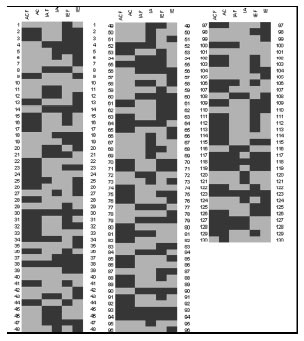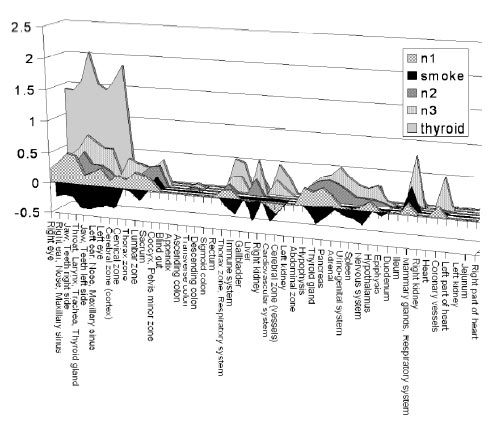Gallery
Bio-electrographic method for preventive health care
*Cohly H., ***Kostyuk N., *Isokpehi R., **Rajnarayanan R.
* Jackson State University, Jackson, MS 39217, USA;
** Tougaloo College, Jackson, Mississippi, USA;
*** University of Aveiro, Portugal.
Introduction
Bio-electrography is a promising direction in the construction of new non-invasive automatic procedures that assess the body's condition during minimum interventions into vital functions [1]. The diagnosis of predisposition to some diseases, the choice of the most adequate treatment policy and the monitoring of human bioresponses to various environmental factors are important aspects in preventive health care services [2].
Bio-electrographic method based on gas discharge visualization (GDV) technique investigates human functional states, by assessing electro-optical parameters of the skin that are based on the registration of physical processes emerging from electron components of tissue conductivity [1]. This technique allows one to capture the image of Electrophotonic impulse around human fingertips and extract information about sympathetic and parasympathetic activities. The quantitative difference in parameters between two systems, which is equal to autonomic tone, and called activation coefficient (AC) can be used as the indirect measure for cognitive function. Integral area of Electrophotonic impulse (IA) is a presentation of calculated fractality level and consistency of the captured image. Integral entropy (IE) is a measure of the deviation from the functional physiological and psycho emotional balance.
Bio-electrographic approach has been used in investigating human functional states, electro-optical parameters of the skin, post-surgery recovery progress and cancer diagnosis and treatment[2],[3]. The objective of our research was to create the dataset, which could serve as a background for an alternative method of preventive diagnostics based on impulse analysis of fingertips’ photonic emission. Photonic emission varies from person to person and reflects his/her psycho-emotional and physical state at the moment of study. Thus, bioelectrographic approach can then be used as a model to bridge the gaps in health disparities by creating an innovative approach to address health aspects in real time measurements, which will improve rural health outcomes.
Our pilot study encompasses 130 participants of average age of 25. We used bio-electrographic methods to collect the base values of study participants and establish possible deviation from the standard norms. Our goal is to implement the bio-electrographic method into preventive health care services and use for recordings of functional physiological and psycho-emotional status of individuals in all social settings. Thus, three parameters selected for the analysis within the group of 130 individuals were: (1) AC, (2) IA and (3) IE.
I. Methods
A. The Institutional Review Board (IRB) Approval
The IRB approval of the consent form was obtained according to the guidelines prescribed by the Review Board.
The majority of the participants were residents of Mississippi, both males and females of average age of 25 years. Each participant was informed that the results will be published in a medical book or journal, or used to teach others.
B. Equipment, Software and Procedure
The participants were asked to sign the consent form where it was emphasized that their participation was voluntary and that they could withdraw at any time. Before signing the consent form, the participant could refuse to take part in the study. The study was conducted using impulse analyzer "GDV Compact" based on Gas Discharge Visualization (GDV) technique. Each participant was asked to place fingers correctly on glass surface. The pictures of electro-photonic emission of all ten fingertips were taken with and without filter. The filter allows no direct contact of fingers to the glass surface. This is necessary to measure the parasympathetic innervations of fingertips while the direct contact to the glass surface measures the sympathetic innervations of fingertips.
Under a high intensity electromagnetic field, finger emits a burst of electrons and photons. With the help of an optical system and camera the discharge’s fluorescence is transformed into video-signals, which are recorded in the form of single shots (GDV grams).The data processor represents a specialized software complex, which allows the calculation of the system parameters. The software GDV Diagram allows carrying out standardized processing of GDV images: capturing GDV-images, filtration of GDV-images, obtaining numerical characteristics, creation of graphs and diagrams, saving data and transfer of data for additional processing. The standard values for Integral Area (IA) fall in the range of (-0.6 to 1.0), Integral Entropy (IE) in the range of (1.0-2.0) and Activation Coefficient in the range of (2.0-4.0). Quality control testing was done in Russia and is the basis of the software that we are employing.
C: Binary selection matrix criterion and Statistical Analysis
The IA, IE and AC mean values for 130 participants were recorded with and without filter. The relationship between IA, AC and IE was assessed by binary selection metric criteria of 3 factors AC, IA and IE mean values as basis of representing a value of 1 for values ≥ mean and a value of 0 for less than mean values.
II. Results
66 participants out of 130 whose binary number was 1 in the AC category, 40 paticipants (GDV-grams with filter) and 53 participants (GDV-grams without filter) in the IA category, 68 participants (GDV-grams with filter) and 68 participants (GDV-grams without filter) in the IE category.
These data was used to construct binary mapping as shown in Figure 1. In our binary mapping 1 was for values ≥ mean and 0 was for values < mean. The mean values were 1.90 for AC, 0.30 for IA without filter and 0.11 for IA with filter and 1.99 for IE without filter and 1.94 for IE with filter.

Figure 1. Binary distribution of IA, AC and IE ± filter for 130 participants. Black = 1, Grey = 0
The results of binary mapping in Figure 2 indicated six participants out of 130 as having possible deviations in health status. Figure 3 compares the mean parameters of five participants corresponding to their functional states.

Figure 2. Distribution of mean individual physiological parameters of organs and systems in the normals and individuals with deviations from the norm (smoker with more than 20 cigarettes per day and a participant with hormonal disbalance)
III. Discussion
Individual parameters of 130 participants were processed to generate mean values of integral area, integral entropy and activation coefficient and analyzed using binary matrix analysis. Table 1 shows an extract from data corresponding to the mean values of activation coefficient, integral area and integral entropy for the group of 130 participants.
Specifically the average AC was 1.966 compared to the standard norm ranging from 2 to 4, IA was ranging from 0.3 to 0.11 compared to the standard norm ranging from -0.6 to 1.0 whereas IE was ranging from 1.94 to 1.99 compared to the standard norm ranging from 1.0 to 2.0. Thus, our pilot study of a group of 130 individuals shows close agreement with the values defined as a standard norm. Binary matrix analysis of the distribution of mean values is a promising step towards defining base line values for disease profiles.
We compared individual parameters of 5 individuals (Figure 3) out of which three had normal values, one had some values below the norm (smoker), and one had some values above the norm (hormonal disbalance). The participant with thyroid hyperactivity had increased activity with and without filters corresponding to first right (sectors 3-8) and first left fingers (sectors 1-8) ranging from 1.01-1.53 on right side and from 1.81-2.52 on left side. These sectors of hyperactivity correspond to eyes, ears, nose, maxillary sinus, jaws, teeth, throat, trachea, larynx, thyroid gland and cerebral zone (sectors 3, 1 and 7, corresponding to liver, cardiovascular system and cerebral zone vessels) ranging from (0.68- to -1.32). Further, fourth left finger (sectors 6-8) ranging from (-0.67 to -1.61) corresponding to hypophysis, thyroid gland and pancreas whereas the fourth right finger (sectors 7-9) range from -0.70 to -0.87. Participant’s medical history of hormonal imbalance confirmed bio-electrographic observation.
The participant with smoking habit of consuming 20 cigarettes per day had an integral area lower than norm and showed low activity (GDV-grams without filter) on first left and right fingers (sectors 1-8) ranging from (-0.89 to -2.83) on left side and (-0.80 to -3.0 ) on right side. Also third left finger (sector 5-immune system with value of -0.62) showed tendency towards low activity within the limits of norm.
However, respiratory system despite of it being inside the norm showed the most active electro-photonic emission. The participants with health problems showed deviation from the norm towards increased activity of certain organs. Figure 1 represents pictures with filter of electro-photonic emission of the individual with thyroid problem. It contains the captured images of 10 fingertips of both hands beginning with a topmost image of the right hand thumb. The fourth sector in the first picture in upper row and the first picture in lower row corresponds to the area of throat, larynx, thyroid gland and trachea demonstrate hyperactivity in this region which is displayed by more intense area of electro-photonic emission and granularity of image quality. The integral parameters of area and activation coefficient were corresponding to the norm whereas entropy was increased to 0.15 above the norm for right side and 0.01 for left side.
IV. Conclusion
Bio-electrographic method was recognized and successfully implemented into preventive health care systems. This technique is non-invasive and proved to be accurate in recording and interpreting functional state of individuals. We developed the bio-electrographic dataset of residents of Mississippi, mainly of African-American origin of average age of 25. We found our results corresponding to the standard norms of bioelectrographic parameters. Bioelectrographic method can be used as an alternative preventive method to analyze functional physiological and psycho-emotional status in real time [3]. The areas of application include sports medicine, fatigue, stress and anxiety studies, rural medicine, clinical psychology, post surgery recovery, correct choice of medication and preventive health care services [4]. Alternate therapies like far infrared treatment [5]-[7] have been shown to improve functional state as observed by recordings of bioelectrography.
References
1. Korotkov KG 2002. Human Energy Field: Study with GDV Bioelectrography. Backbone Publish Co.Fair Lawn
2. Korotkov K. G., Popechitelev E. P. 2002. Method for gas-discharge visualization and automation of the system of realizing it in clinical practice.Med.Tekh. 21-25.
3. Rubik B. 2002. The biofield hypothesis: its biophysical basis and role in medicine. J.Altern.Complement Med. 8:703-717.
4. Bell I. R., Lewis D. A., Brooks A. J., Lewis S. E., G. E. Schwartz. 2003. Gas discharge visualization evaluation of ultramolecular doses of homeopathic medicines under blinded, controlled conditions. J.Altern.Complement Med. 9:25-38.
5. Lin C. C., Liu X. M., Peyton K., Wang H., Yang W. C., Lin S. J., W. Durante. 2008. Far infrared therapy inhibits vascular endothelial inflammation via the induction of heme oxygenase-1. Arterioscler.Thromb.Vasc.Biol. 28:739-745.
6. Masuda A., Kihara T., Fukudome T., Shinsato T.,Minagoe S., Tei C. 2005. The effects of repeated thermal therapy for two patients with chronic fatigue syndrome. J.Psychosom.Res. 58:383-387.
7. Masuda A., Munemoto T., Tei C. 2007. A new treatment: thermal therapy for chronic fatigue syndrome. Nippon Rinsho 65:1093-1098.
- Login to post comments
User login
Last articles










